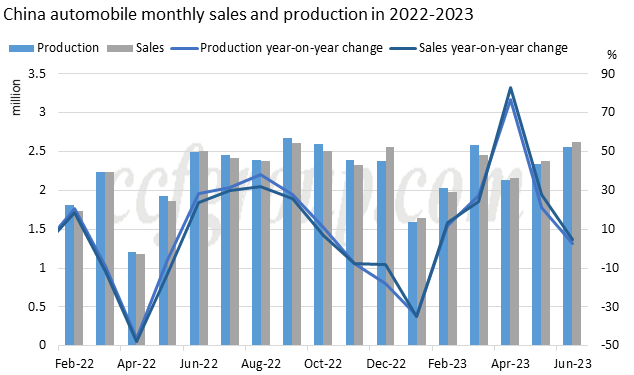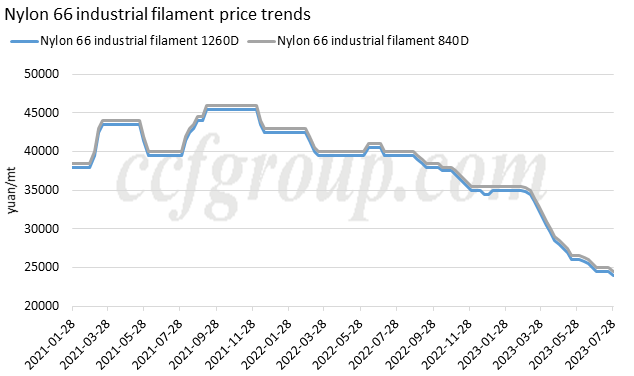Automobile-related nylon market needs time to recover
On May 9, 2023, several ministries jointly issued an announcement regarding China's VIb vehicle emission standards for automobiles, which cleared uncertainties in the market.
The announcement included two main points:
First, starting from July 1st, China VIb emission standards will be fully implemented nationwide.
Second, a six-month sales transition period will be granted for "China's VIb vehicle emission standards + Real Driving Emissions (only detect)" vehicle models. The implementation of these policies also provided automobile dealers with a certain amount of time to clear their inventory, stabilize market price expectations, reduce short-term price fluctuations, alleviate consumer hesitation, and drive the conversion of demand into sales.
According to data from the China Association of Automobile Manufacturers (CAAM), by the end of January 2023, there were over 1.89 million non-compliant inventory vehicles and over 2 million inventory vehicles, including purchased components, that did not meet the RDE requirements. At that time, due to the aggressive price reductions and promotions by car manufacturers and dealers, consumers were mostly in a wait-and-see stance, which even affected the production plans of some manufacturers. However, after several months of inventory clearance, the inventory of China VIa vehicle models was basically consumed before the new regulations were implemented. The policy also provided a six-month sales transition period for "China VIb non-RDE vehicle models," giving automakers enough time to wrap up.
In addition, National Development and Reform Commission (NDRC) released the "Implementation Opinions on Accelerating the Construction of Charging Infrastructure to Better Support the Rural Revitalization and Adoption of New Energy Vehicles in Rural Areas".
The policies are expected to drive the demand for PA 6/66 modified plastics, halogen-free flame retardant reinforced PA, and high-temperature nylon for the construction of charging stations for new energy vehicles. It is hoped that the policy support in the third quarter will stimulate the production and sales of automotive nylon and help downstream enterprises overcome their current challenges.
Looking back at the first half of 2023, the production and sales data of automobiles from January to June increased by 9.3% and 9.8% respectively compared to the same period last year. Exports reached a record high, with China's automobile exports reaching 2.14 million units in the first half of 2023, a year-on-year increase of 75.7%.

In June 2023, automobile production and sales reached 2.561 million and 2.622 million units respectively, representing a month-on-month growth of 9.8% and 10.1% respectively. Compared to the same period last year, production and sales increased by 2.5% and 4.8% respectively. From January to June 2023, automobile production and sales totaled 13.248 million and 13.239 million units respectively, with a year-on-year growth of 9.3% and 9.8% respectively.
From the perspective of terminal data alone, the automobile market should perform well this year, but the figure in upstream automobile-related nylon 6 and nylon 66 market is not as good. The operating rate and prices of nylon 6 and 66 plastics are hard to elevate in the year. Nylon 6 industrial-grade chip plant operating rate has just climbed up to 71%, and nylon 66 chip plant operating rate has lingered low at 55% for a long term. Prices of nylon 66 chip and industrial filament have been continuously falling.

Why are the automotive-related nylon 6 and nylon 66 plastic market still poor?
First, it is affected by the weak trend of commodity prices. The futures prices of PE, PVC, and PP have experienced declines ranging from 7.3% to 14.1% this year. Due to the weakening expectations of raw material prices, the market conditions for general plastics and engineering plastics have been relatively flat. Similarly, engineering plastics such as PA6 and PA66 have been negatively affected by the overall downturn in the industry, with average market prices falling by 8.4% and 7.7% respectively since the beginning of the year. Poor price expectations and lackluster market transactions have put downstream manufacturers and traders in a dilemma during the mid-year, making it difficult to predict the market trend in the second half of the year.
Second, July and August are traditionally the off-season for the market. The supply side has been operating at low levels in the first half of the year (with PA6 operating at around 70% capacity and PA66 at around 60% capacity), while demand targets have been repeatedly lowered. If production is further reduced in the next stage, the income and profitability of companies will be further compromised. However, there is insufficient confidence in the market recovery in the third quarter, making it challenging for companies to maintain a balance between maintaining production and controlling sales. Many distributors have reduced their inventories and operations to buy themselves more time in the face of unpredictable market trends.
Despite of the favorable policies, it still takes some time for the market to digest the policies related to nylon plastic materials, the overall market outlook suggests a potential turning point. In the second half of the year, it is advisable to manage expectations, focus on product quality, and patiently await market opportunities.
- Top keywords
- Cotton Price
- Cotton Futures Price
- Cotton Futures
- CZCE
- PTA Futures Price
- Chemical Fiber
- Polyester Prices
- Wool price
- PTA Futures
- Shengze Silk
- China
- Yarn Price
- price
- China Textile City
- Fibre Price
- Benzene Price
- Cotton
- Index
- Cotton Index
- PTA
- fabric price
- NYMEX
- Top 10
- textile industry
- Spot Cotton
- Cotton Yarn
- Polyester Price
- Futures
- PTA Price
- cotton yarn price

